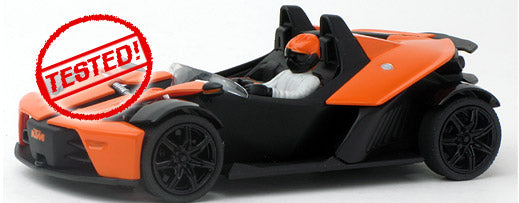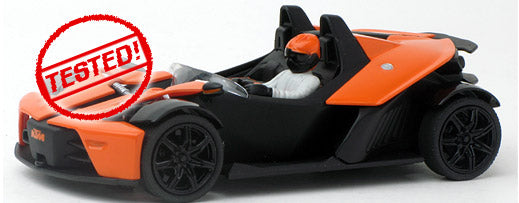
Carrera Evolution KTM X-Bow
Carrera Evolution KTM X-Bow

(analog 27248)
The love-hate relationship…
There are racetrack cars (or slot cars in modern parlance) that you would never buy. You see pictures of the real thing, and you just don't like the vehicle. Too weird, too ugly, too unusual. The X-Bow is one such vehicle. I just find it ugly. You could give me the real thing as a gift, and I wouldn't want it.
The original was first presented at the Geneva Motor Show in 2007. Initially limited to 100 units (and already completely sold out), the X-Bow is a no-compromise vehicle. Audi four-cylinder turbo engines from 220 to 260 hp, a carbon monocoque, and a Brembo brake system. You won't find any useless child's playthings like air conditioning, a radio, etc. But the X-Bow simply has a very distinctive look. And that's precisely why I would never buy one. For me, a sports car is also about design.
And now I'm supposed to test it as a slot car. Okay, admittedly, the body is excellent and absolutely true to the original. And the matte black and orange combination just works. The sparse printing is cleanly executed, and the body overall makes a very sturdy impression, making it suitable for children's hands. The rims with the treaded tires are very nice.
Let's get to the technical details: The car weighs 86g, making it one of Carrera's lightest cars. The distance between the guide keel and the rear axle is, in my opinion, perfectly implemented. The guide keel is too stiff for my taste; in such cases, I remove the guide keel spring, but this, of course, doesn't reset the keel. The double sliding contactors have proven themselves at Carrera and are easy to replace. The interchangeable rear axle unit isn't to everyone's taste, but it makes replacing the axle much easier. Loosen two screws, fold out the entire unit, unclip the axle, and the new parts can be installed.
Anyone who wants to completely disassemble the car will first have to remove the axle unit; the screw for the base plate is located under the rear axle. Due to its design, the chassis itself is very tight. Therefore, you should be careful not to pinch any cables during reassembly.
Let's move on to the handling: Despite the very narrow tires, the KTM sits like a board on the track. The tires have very good grip, and even with a magnet, it's almost impossible to throw it off course. The car handles like a go-kart; it's almost impossible to take off. But if you remove the rear magnet, things get really fun. Drifting until you (lately) take off—this thing is simply fun.
Conclusion : For me, this is the vehicle with the highest play and fun factor that Carrera currently has in its range, suitable for fathers and sons alike. If only it weren't so ugly... :-)
CoMod Lotus
-----------------------------------------------------------------------
Review by CoMod JoergW on the KTM X-Bow
(analog 27248)
1. Optics:
The orange-and-black flat-bottomed car's trim is clearly visible, even though the name 'Speedster' has already been used elsewhere. No superfluous parts that would even remotely dilute the pure driving pleasure have been installed on this vehicle. This orange sports car could even make it to the finals, purely on aesthetic grounds. The car is polarizing. You either like it or you don't, I do.
For about 1/100 of the full-price price, the car racing enthusiast can enjoy it on their own track—not just the visual pleasure, but also the driving experience. One 'advantage' of slot racing becomes particularly clear here: you're not sitting in the car and getting back problems, but can relax and aim for the lap record on your home track.
2. Technology
Here, proven technology is combined with the new rear axle removal option. In the case of the KTM X-Bow, however, it's important to note that the rear magnet must first be removed; underneath is the screw for releasing the rear axle. Once the chassis is disassembled, reassembly should be carried out carefully to avoid pinching any cables. The vehicle is not equipped with lights, which could be due to the rather tight space.
3. Processing
The vehicle is detailed, but not too delicate, making it suitable for children's hands, once dad lets go.
4. Driving behavior
The orange and black X-Bow, weighing just 88 g, is the lightweight in the starting field and can certainly be optimized. Personally, however, I'd consider the modifications too radical. The narrow tires offer very good grip, only slightly less than the Golf GTi. The treaded version looks very appealing. Since the tire material used appears to be the same as in the Golf, the reason for the slight difference could be found in the tire width and the general differences in the vehicle construction. With both magnets, the X-Bow is perfectly easy to maneuver around the track, even for beginners, but it's only really fun with the center magnet. Drifting fun until the limiter kicks in. Definitely a fun car that can be driven quickly even on twisty home tracks with a high proportion of Turn 1!
5. Miscellaneous
A fundamentally well-suited selection of vehicles to complement the 1:32 scale range. The orange and white versions look almost like teams competing in an international match between neighboring nations. Two more bold, highly visible colors could be added next year to increase the starting field. However, if Carrera were to release a kit with two or three differently colored interchangeable upper sections or bodyshells in the Club... then yes, there would be possibilities. That would really be a different idea for a 'limited' 1:32 scale.
CoMod JoergW












































































